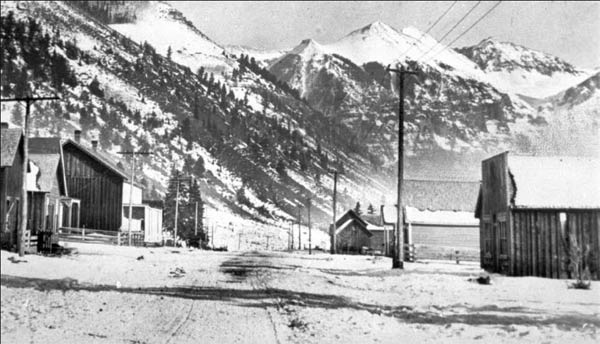Eileen McGinley is a writer, political activist and organizer, and volunteer Cub Reporter for KOTO news. She has recently completed a novel, yet to be published, called Once Upon The Seventh Time. Eileen lives, works and plays in Telluride. This piece was written for the application to place the Valley Floor on The National Trust for Historic Preservation’s Most Endangered Places List in 2001. A History of the Valley Floor Since the time of the Utes, the Valley Floor has been the gateway to the box canyon, and for more than one hundred years, the Valley Floor has been the lens through which Telluride’s historic scale and perspective has been viewed. According to Ute elder Alden Naranjo, a consultant for Native American Ute history, upwards of 600 Utes camped on the Valley Floor every summer. Their camp began at what is now known as Society Turn and spread east to the end of Telluride’s box canyon. It could be said that the Utes and Mother Nature established the historical boundaries for Telluride. In 1868 the Utes signed a treaty with the U.S. that “granted” them about one-quarter of present-day Colorado, which included the mineral-rich San Juans. Only four years later, in 1872, prospectors Linnard Remine and his companions—possibly the first white men to enter the San Miguel Valley since the fur traders—illegally started placer mining on the Ute Reservation. The gold rush was on. In 1873, the Utes were forced to cede four million acres of the San Juan Mountains to the U.S. government for a perpetual yearly annuity of $25,000, mostly in the form of goods. The Hayden Survey group mapped the San Miguel Valley in 1874. In the same year, John Fallon found a rich deposit of gold ore in Marshall Basin. By the summer of 1875 over three hundred men were working the San Miguel River, including the stretch that runs along what is now known as the Valley Floor. The first mining camp was situated on the Valley Floor and eventually grew into a town called San Miguel City. Placer mining along the San Miguel River led F.P. Brown, Thomas Lowthian and J.H. Mitchell up to the San Miguel Valley, where in August of 1877 they laid out a camp site in an attractive pine and cottonwood grove beside Mill Creek. While it’s not exactly clear why this spot in the valley was chosen other than its access to good water, it may have been a split-the-difference compromise between the Keystone placers two miles to the west, and the trail up to Marshall and Savage basins a mile and a half to the east. In July of 1877 Brown became postmaster for the first post office in the new San Miguel Mining District. An intrepid Mrs. John Carroll hosted the first restaurant. Charles Sharmon surveyed the town in the fall of 1877. During the summer of 1879 a semi-weekly mail service was established between Silverton and San Miguel City by way of Ophir. By 1880 San Miguel City had several goods stores, a hotel, two stamp mills, and one concentrating works, plus some two hundred people. That same year James Bishop and Joe White started a meat market, while Dave Cooper packed meat to the miners in the basins. But by 1882, San Miguel City’s preeminence in the valley began to wane. As one early settler remembered, “They charged too much for lots.” As a result, most newcomers moved on to Telluride, a mile or so up the canyon. San Miguel City continued on as a small community (even up into the present—although it’s now locally known as the Brown Homestead), but its promise as the valley’s first real city seems to have failed because of greed, a familiar story hereabouts. By 1885, when folks got around to filing the plat of the town site, San Miguel City had 175 people compared to Telluride’s 850.
In 1890, the Rio Grande Southern railroad rolled into Telluride across the Valley Floor. For the next forty years the Valley Floor saw a variety of uses under public and private ownership, as the site of dairies, recreation, and a dump for mine tailings. (According to some old-timers, in the mid-1900s, the tailings ponds down at Society Turn were a favorite spot to play softball, while women and children sunbathed and played on the tailings sand. As the story goes, these tailings washed down river during the flood of July 1914, when a cloudburst above Cornet Creek sent a torrent of water through the Liberty Bell Mine waste dump, through the small dam at the foot of the canyon, down Oak Street to Colorado Avenue. The industrious Telluride miners used powerful fire hoses and a sluice to wash away the debris. The waste ran down the San Miguel River and some of it collected at the end of the valley.) Somewhere between the late 1800s and the early 1900s, the term “Society Turn” evolved to describe the intersection where State Highway 145 takes a sharp turn south, and a spur takes you into Telluride. Some old-timers say Society Turn got its name because every Sunday the gentry used to dress up and promenade their buggies out to the end of town, at which point “society” turned around and headed back to town. Today, Society Turn still marks the beginning of town, and the beginning of the Valley Floor. In 1930, Joe Oberto began buying up pieces of the patchwork claims on the Valley Floor with the goal of consolidating the land into one large parcel. In 1967, the Oberto Family sold the Valley Floor to the Newmont Mining Company (Idarado) for less than $300,000. Idarado intended to use the property to dump tailings and house employees. Telluride citizens opposed the plan, and forced Idarado to stop dumping tailings. Idarado sold the Valley Floor to Denver-based Cordillera Corporation for $6 million in 1983. Cordillera is the parent company of the current Valley Floor owners, San Miguel Valley Corporation (SMVC). In the mid-’80s, SMVC presented development plans for the 880-acre Valley Floor. Their plans depicted a series of reservoirs, a golf course, and a population of 7,000. SMVC never pursued these plans. Between 1991 and 1999, the Town of Telluride and San Miguel County governments battled SMVC over many issues. Late on March 31, 1993, one of SMVC’s consultants mistakenly sent a fax intended for SMVC to the County Planning department—this became know as The April Fool’s Fax. This fax contained development plans for the Valley Floor, which revealed SMVC’s intention to drain the wetlands as a way to increase their developable property. In September 1999, a district court judge handed a victory to SMVC, saying the railroad right-of-way belonged to the company and not the Town of Telluride. The railroad was abandoned in 1953—the right-of-way, which crosses the Valley Floor, was first conveyed to San Miguel County, which later turned it over to the town. The judge called the County’s conveyance of the land to the town an error. In December of 1999, SMVC revealed updated plans for development on the Valley Floor. These plans included a large hotel complex, a gondola link to 41 Mountain Village, an 18-hole golf course, commercial areas, condominiums, and single homes. On June 5, 2000, SMVC officials announced they intended to seek annexation of the Valley Floor into Mountain Village (the ski company town on the other side of the hill) and pursue development with that town. This announcement incited the public, as it was judged to be an attempt by SMVC to align themselves with a political body that would allow development patterns and building sizes not in scale with the Town of Telluride. On June 25, 2000, at a packed meeting, the Telluride Town Council fired back, and directed staff to begin immediate work on appraisals, legal documents and boundary surveys of the Valley Floor in preparation for condemnation. The move met with cheers. On July 3, 2000, a public demonstration drew approximately 1,500 people to the County Courthouse steps (the courthouse is an historic building in the center of Telluride) for a Rally for the Valley, with participants roaring, “Free the Valley.” As reported by The Denver Post, “Dreadlocks cozied up to designer pants suits, movie stars linked up with ranch hands, tie-dyes connected to Ph.D.s, second-home owners gripped tent dwellers, tots hung on to retired miners. ‘Save the floor. Save the cows,’ chanted about 1,500 residents of this mountain town who turned out at high noon to form a human chain in a traffic-snarling protest against the planned development of the “valley floor”—the 880 acres of scenic meadows and wetlands spotted with black-and-white cows that stretch along Colorado 145 at the entrance to Telluride.” Facing growing opposition, SMVC suspended its efforts to annex the Valley Floor to Mountain Village on August 14, 2000. The company said it would back away from the political fray and continue to hold on to the property. On June 25, 2002, Telluride residents voted 609- 385 in a special election to pursue eminent domain for attainment of 570 acres on the south side of the Valley Floor to be placed under a conservation easement in perpetuity. SMVC has said the company is preparing for a court battle over the future of the Valley Floor. Nothing stirs the old clay of the heart more than the three-mile approach from Society Turn to Telluride. It is a vista that conveys more than the imagination is able to conceive. Through fences, groves of cottonwoods and spruce, and open meadows, we see the historic town nested in the natural contour of the alpine valley. Everything looks right; we feel a balance, a connection, and a touch of humility. We are transported to a place of beauty within ourselves. If we lose the Valley Floor, we lose a rare thing to behold in our fragmented world—a vision of wholeness. We lose our natural symmetry and sense of connection. And we lose the main theme of Telluride’s history— man surrounded by nature. Appendix Citations from Art Goodtimes Historic Archives Russ Collman and Dell A. McCoy, The RGS Story, Rio Grande Southern, Vol. II, Telluride, Pandora and the Mines Above, Sundance Publ. Ltd., Denver, 1991. Colorado Writers Project of the WPA, “Place Names in Colorado” (S), Colo. Mag #19, 1942. Ray L. Newburn, Jr., Postal History of the Colorado San Juans, 1974 (monograph published serially in the Western Express 1975-1983). D. Ray Wilson, Colorado Historical Tour Guide, Crossroads Communications, Carpenterville, Illinois, 1990. Frank Hall, History of the State of Colorado, Vol. IV, Chicago, 1889. L. G . Denison & L. A. York, Tale of Two Early Pioneers, Indesign Studios, Odessa, Texas, 1988. G. A. Crofutt, Grip-Sack Guide of Colorado, Overland, Omaha, 1881. New Popular Family Atlas of the World/ J.V. Farwel & Co., Chicago, 1891 1 Alden Naranjo consults with the U. S. Parks and Forest
Services. He was a major contributor to Ute Indian Art and Culture,
from Prehistory to the New Millennium, edited by William Wroth. |
||||||||
|
|
||||||||
| |
info@valleyfloor.org ©2014 Valley Floor Preservation Partners |
|||||||
| |
|
|
|
Valley Floor Preservation Partners • PO Box 202 • Telluride, CO 81435



 "San
Miguel City," taken between 1880 and 1890, photographer unknown.
San Miguel City, the first town in the Telluride valley, was located
in the area of Brown Homestead. [Courtesy of The Denver Public Library,
Western History Collection, Call # X-13522]
"San
Miguel City," taken between 1880 and 1890, photographer unknown.
San Miguel City, the first town in the Telluride valley, was located
in the area of Brown Homestead. [Courtesy of The Denver Public Library,
Western History Collection, Call # X-13522]